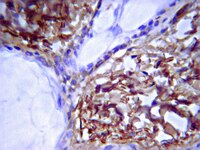Differential regulation of cell functions by CSD peptide subdomains.
Reese, C; Dyer, S; Perry, B; Bonner, M; Oates, J; Hofbauer, A; Sessa, W; Bernatchez, P; Visconti, RP; Zhang, J; Hatfield, CM; Silver, RM; Hoffman, S; Tourkina, E
Respiratory research
14
90
2013
Mostrar resumen
In fibrotic lung diseases, expression of caveolin-1 is decreased in fibroblasts and monocytes. The effects of this deficiency are reversed by treating cells or animals with the caveolin-1 scaffolding domain peptide (CSD, amino acids 82-101 of caveolin-1) which compensates for the lack of caveolin-1. Here we compare the function of CSD subdomains (Cav-A, Cav-B, Cav-C, Cav-AB, and Cav-BC) and mutated versions of CSD (F92A and T90A/T91A/F92A).Migration toward the chemokine CXCL12 and the associated expression of F-actin, CXCR4, and pSmad 2/3 were studied in monocytes from healthy donors and SSc patients. Fibrocyte differentiation was studied using PBMC from healthy donors and SSc patients. Collagen I secretion and signaling were studied in fibroblasts derived from the lung tissue of healthy subjects and SSc patients.Cav-BC and CSD at concentrations as low as 0.01 μM inhibited the hypermigration of SSc monocytes and TGFβ-activated Normal monocytes and the differentiation into fibrocytes of SSc and Normal monocytes. While CSD also inhibited the migration of poorly migrating Normal monocytes, Cav-A (and other subdomains to a lesser extent) promoted the migration of Normal monocytes while inhibiting the hypermigration of TGFβ-activated Normal monocytes. The effects of versions of CSD on migration may be mediated in part via their effects on CXCR4, F-actin, and pSmad 2/3 expression. Cav-BC was as effective as CSD in inhibiting fibroblast collagen I and ASMA expression and MEK/ERK signaling. Cav-C and Cav-AB also inhibited collagen I expression, but in many cases did not affect ASMA or MEK/ERK. Cav-A increased collagen I expression in scleroderma lung fibroblasts. Full effects on fibroblasts of versions of CSD required 5 μM peptide.Cav-BC retains most of the anti-fibrotic functions of CSD; Cav-A exhibits certain pro-fibrotic functions. Results obtained with subdomains and mutated versions of CSD further suggest that the critical functional residues in CSD depend on the cell type and readout being studied. Monocytes may be more sensitive to versions of CSD than fibroblasts and endothelial cells because the baseline level of caveolin-1 in monocytes is much lower than in these other cell types. | 24011378
 |
Focal adhesion kinase modulates cell adhesion strengthening via integrin activation.
Michael, KE; Dumbauld, DW; Burns, KL; Hanks, SK; García, AJ
Molecular biology of the cell
20
2508-19
2009
Mostrar resumen
Focal adhesion kinase (FAK) is an essential nonreceptor tyrosine kinase regulating cell migration, adhesive signaling, and mechanosensing. Using FAK-null cells expressing FAK under an inducible promoter, we demonstrate that FAK regulates the time-dependent generation of adhesive forces. During the early stages of adhesion, FAK expression in FAK-null cells enhances integrin activation to promote integrin binding and, hence, the adhesion strengthening rate. Importantly, FAK expression regulated integrin activation, and talin was required for the FAK-dependent effects. A role for FAK in integrin activation was confirmed in human fibroblasts with knocked-down FAK expression. The FAK autophosphorylation Y397 site was required for the enhancements in adhesion strengthening and integrin-binding responses. This work demonstrates a novel role for FAK in integrin activation and the time-dependent generation of cell-ECM forces. Artículo Texto completo | 19297531
 |
Arrangement of collagen fibers in human placental stem villi.
Leyla Sati,Ayse Yasemin Demir,Levent Sarikcioglu,Ramazan Demir
Acta histochemica
110
2008
Mostrar resumen
The aim of the study was to investigate the arrangements and related localization patterns of different collagen types in the stroma of placental stem villi by immunohistochemistry and electron microscopy. A total of 14 normal human term placental tissue samples were studied. Immunohistochemistry was performed in order to localize collagen types I, III, IV, V and cytokeratin 7 on tissue sections. Parallel tissue samples were examined by transmission electron microscopy. Semi-quantitative analysis of immunolabeling intensities was also performed to determine the distribution of fibers in stem villi stroma. All collagen types, especially collagen type V, were strongly immunopositive in the triangular areas of the stem villi stroma. However, there was no collagen type I or type III immunolabeling in the sub-trophoblastic regions. Membrane collagen type IV immunolabeling was also observed in the stroma of stem villi. Ultrastructurally, collagen fibers showed different configurations in cross, longitudinal, circular, oblique and parallel directions compared to the villous axis. We conclude that the organization of collagen fiber bundles in stem villi shows a very specific arrangement: a compact coat formed by fibrillar bundles between the vascular wall and extravascular stroma of stem villi correlated with the functional activity. | 18275985
 |

















